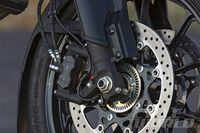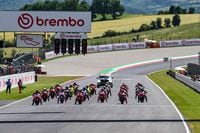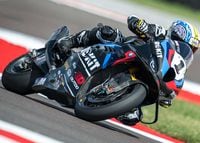Most bikes differ from cars in that they have separate front and rear brakes, while most cars' brakes function as one. In addition, motorcycles use different front and rear tires; weight shift is also a major part of a motorbike's stopping performance. Anti-lock brake systems for bikes and cars face different challenges.
Anti-lock braking systems (ABS) are relatively new for bikes. There’s no one standard system. But all ABS work in a similar way: they compare front- and rear-wheel rotation speeds, and if one wheel is locking up under braking (skidding), ABS momentarily releases braking force to that wheel and then re-applies it. The best systems do this about 24 times a second—much faster than any human.
Many also automatically apply both brakes, linking the front and rear. Your rear-brake pedal still (mostly) controls the rear brake, but applies some front brake as well; ditto for the front-brake lever.
ABS helps you stop faster because it helps to eliminate skidding, though it will do nothing for increased stopping distances on wet roads or ice. But since most riders tip over if they lock a wheel, anti-lock brakes are a real benefit. They’re usually more costly, add weight and complexity to a bike, and some riders resent the perceived loss of control.

/cloudfront-us-east-1.images.arcpublishing.com/octane/DS3Q5X2VJFFAJDK2PWB3Y7K6U4.jpg)
/cloudfront-us-east-1.images.arcpublishing.com/octane/4KBL4JAMYRFDPEINTWATDUH7OM.jpg)
/cloudfront-us-east-1.images.arcpublishing.com/octane/FXADK3MVSNBRTKJ2B7TPDCCJ5Y.jpg)
/cloudfront-us-east-1.images.arcpublishing.com/octane/M7L2CPXO55FRFMECW7QGDPGP6E.jpg)
/cloudfront-us-east-1.images.arcpublishing.com/octane/T4RWGLAEHVE2VCJZOTFTNGB2KA.jpg)
/cloudfront-us-east-1.images.arcpublishing.com/octane/JM4QGLAHWNGHPM74OEB7FVBFSY.jpg)
/cloudfront-us-east-1.images.arcpublishing.com/octane/BGPNXPDDYBHD3HL6YEZQOYHXTI.jpg)
/cloudfront-us-east-1.images.arcpublishing.com/octane/SND5GGQV4RDPPMZBSBEGIZ4SIY.jpg)
/cloudfront-us-east-1.images.arcpublishing.com/octane/XUDDAPYZMZEL5EDPVDJ2DTULWI.jpg)
/cloudfront-us-east-1.images.arcpublishing.com/octane/M7AU2L6GAVCJVHW57LIRPDAAUQ.jpg)

/cloudfront-us-east-1.images.arcpublishing.com/octane/JKEJY7P43JGD5C5NJO2VJQJPUM.jpg)
/cloudfront-us-east-1.images.arcpublishing.com/octane/YROKYJYUQVGPHCEMPTGBWDQCKQ.jpg)
/cloudfront-us-east-1.images.arcpublishing.com/octane/QIHEYR66TZDAPCGMWHCWCBC4XA.jpg)
/cloudfront-us-east-1.images.arcpublishing.com/octane/4FTBMNZL5BD2ZHY62XXRHJW6PI.jpg)
/cloudfront-us-east-1.images.arcpublishing.com/octane/L2BHKRCEMFDF7O3S4REZXPDH2E.jpg)
/cloudfront-us-east-1.images.arcpublishing.com/octane/QHENIV3HMJCTTCXQ6O5YPTNRZ4.jpg)
/cloudfront-us-east-1.images.arcpublishing.com/octane/K3VNQBIAKVGIHIGBRG7QKJYLVI.jpg)
/cloudfront-us-east-1.images.arcpublishing.com/octane/HRU64QXT3NH2DJOFBVI53XIKCE.jpg)
/cloudfront-us-east-1.images.arcpublishing.com/octane/4C5HHSNJCVDZXPIJTCJBVTE2MU.jpg)
/cloudfront-us-east-1.images.arcpublishing.com/octane/HBKK2TCOCZFIBIVKLKZFF5NXLQ.jpg)
/cloudfront-us-east-1.images.arcpublishing.com/octane/23S5ZEY2FBBADHQQK7AKLFDNYM.jpg)
/cloudfront-us-east-1.images.arcpublishing.com/octane/OPF3CNKKLVAN3AHQWD22DPWLEQ.jpg)
